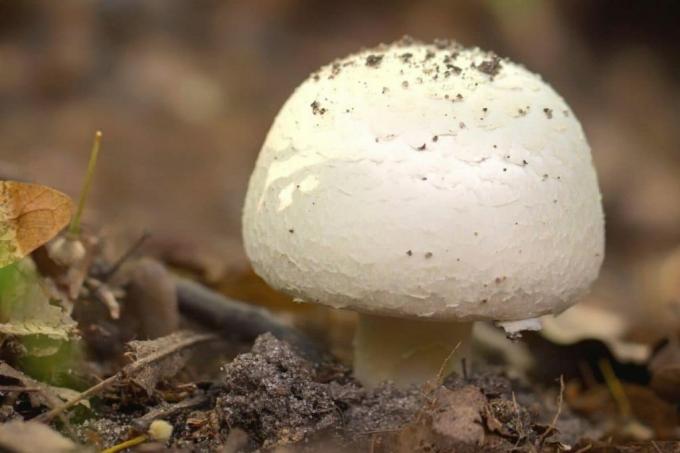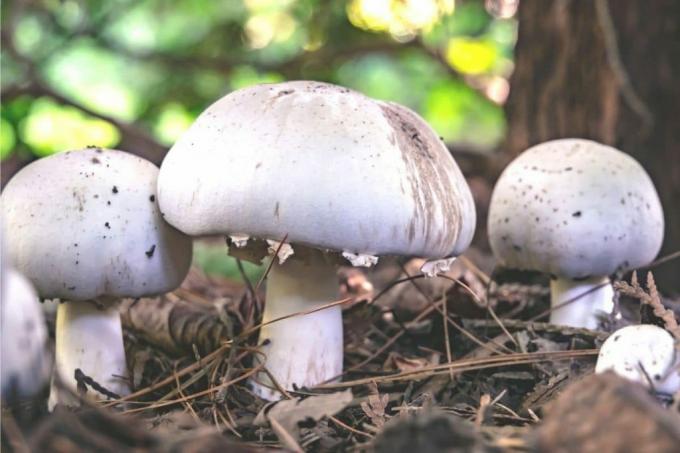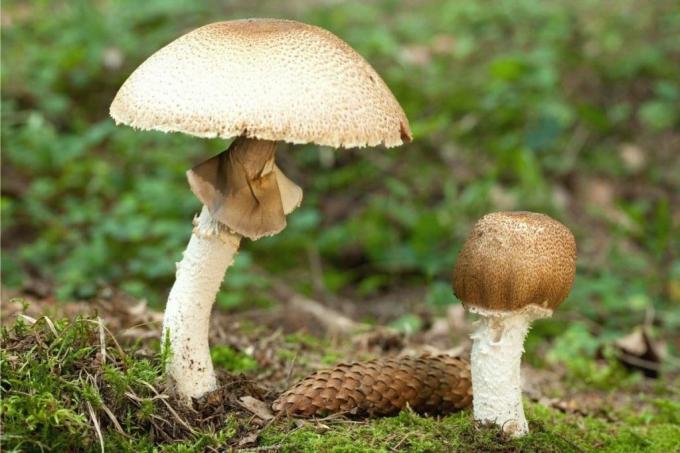
table of contents
- Delicious and healthy
- List of native mushroom species
- From D to K
- From P to S
- From W to Z
- frequently asked Questions
You can not only buy mushrooms in the supermarket, because in this country there are also different types of mushrooms in the woods and fields. Nevertheless, caution is advised when collecting, because not all are edible, some are even poisonous.
In a nutshell
- Mushrooms are real power mushrooms
- also at home in the forest and on the meadow
- some mushroom species have poisonous doppelgangers
Delicious and healthy
Mushrooms (Agaricus), also known as Egerlinge, are one of the favorite mushrooms in this country. Cultivated mushrooms are available all year round in every supermarket. The mushrooms are very healthy and tasty. They are among the healthiest mushrooms ever since they are high in vitamin D, B2, however also biotin, niacin and various minerals such as potassium, copper, selenium, iron and phosphorus contain. You can also collect these power mushrooms yourself, because there are different types of mushrooms that are native to the wild. But be careful, some of them can easily be mistaken for poisonous doppelgangers.
List of native mushroom species
In the list, different types of mushrooms that are native to Germany are presented in terms of their most important identifying features.
Note: If you are unsure when determining a mushroom type, it is always advisable to consult a mushroom advisor.
From D to K
ThinnerAnise gerling (Agaricus silvicola)

- Occurrence: deciduous and coniferous forests, under Book and spruce
- Period: July to September
- Appearance: white hat, diameter 5 to 10 cm, pink to brown Slats, white flesh, 5 to 10 cm long white stem
- Odor: strong aniseed
- Taste: sweet
- Edible: yes, very good edible mushroom
- Risk of confusion: poisonous death cap mushroom
False meadow mushroom (Agaricus pseudopratensis)
- Occurrence: meadows, coniferous forests under spruce trees
- Period: July to October
- Appearance: gray-brownish hat, diameter 2 to 8 cm, pink to reddish-purple lamellas, white-gray, soft flesh, 5 to 10 cm long white stem
- Smell: of turpentine, carbol or iodine
- Taste: inconspicuous
- Edible: no, poisonous
- Danger of confusion: poisonous death cap mushrooms, poisonous carbolic mushrooms
Flaky mushroom (Agaricus subfloccosus)

You can contact this user here.
English | español | français | italiano | македонски | മലയാളം | português | +/− derivative work: Ak ccm, 2012-07-09 Agaricus subfloccosus 235732 crop, Edited by Plantopedia, CC BY-SA 3.0
- Occurrence: coniferous forest under spruce trees
- Period: June to September
- Appearance: gray-white hat, 5 to 15 cm in diameter, pink-colored lamellas, white and firm flesh, 4 to 10 cm long, white to reddish gray stalk
- Odor: slightly sour
- Taste: sweet
- Edible: yes
- Risk of confusion: poisonous death cap mushroom
Large aniseed gerling (Agaricus macrocarpus)
- Occurrence: forest edges, meadows, paths, gravel areas
- Period: July to September
- Appearance: whitish-yellow hat, diameter 5 to 20 cm, pink to black-brown lamellas, white to ocher-colored flesh, 10 to 20 cm long white stem
- Odor: anise-like
- Taste: earthy mild
- Edible: yes
- Danger of confusion: poisonous carbolic mushroom, poisonous white cap mushroom (Amanita verna)
Carbolic mushrooms (Agaricus xanthodermus)

- Occurrence: deciduous and coniferous forests, parks, gardens, meadows, in large groups
- Period: July to October
- Appearance: white hat, diameter 5 to 12 cm, pink to brown lamellas, white flesh, 6 to 12 cm long white stem
- Odor: strong like carbolic
- Taste: very unpleasant
- Edible: no, poisonous
From P to S
Guinea fowl gerling (Agaricus moelleri)

- Occurrence: mixed forest, parks
- Period: June to September
- Appearance: white to light yellow hat, scaled brown, diameter 4 to 13 cm, pink to dark brown lamellae, white to slightly yellowish flesh, 3 to 15 cm long whitish-yellow stem
- Odor: carbolic, slightly like ink
- Taste: mild
- Edible: no, poisonous
- Danger of confusion: edible forest gerling, edible giant mushroom
Giant mushroom (Agaricus augustus)

- Occurrence: deciduous and coniferous forests, mostly on the edge of the forest
- Period: July to September
- Appearance: brownish hat, diameter 10 to 20 cm, white lamellas, white flesh, 10 to 20 cm long white stem
- Smell: of anise
- Taste: very mild
- Edible: yes, very tasty edible mushroom
- Risk of confusion: poisonous guinea fowl gerling
Note: The flakes should be removed before preparation.
Crooked mushroom mushrooms (Agaricus essettei)

- Occurrence: coniferous forests, in groups under spruce trees
- Period: July to October
- Appearance: white hat, diameter 8 to 12 cm, gray lamellas, white flesh, 10 to 14 cm long white stem
- Odor: anise-like
- Taste: mild
- Edible: yes, tasty edible mushroom
- Danger of confusion: deadly poisonous white cap mushroom
Note: The white hat turns lemon yellow when pressed.
City mushrooms (Agaricus bitorquis)

- Occurrence: parks, gardens, rubbish heaps, rubble dumps, roadsides
- Period: May to October
- Appearance: white hat, 3 to 15 cm in diameter, pink to dark brown lamellas, white flesh, 3 to 6 cm long white stem
- Odor: pleasantly mushroom
- Taste: pleasant
- Edible: yes, tasty edible mushroom
- Danger of confusion: poisonous carbolic mushrooms, light-colored amanita mushrooms such as poisonous amanita virosa
Note: Due to their location, these mushrooms are often polluted.
From W to Z
Forest mushroom (Agaricus silvaticus)

- Occurrence: coniferous and mixed forests, often under spruce trees
- Period: July to October
- Appearance: ocher to cinnamon-colored hat, diameter 5 to 10 cm, gray-pink to brown-reddish lamellae, white flesh, 7 to 10 cm long white stem
- Odor: smelling of wood
- Taste: very aromatic
- Edible: yes, good edible mushroom
- Danger of confusion: poisonous flesh-brownish umbrellalings (Lepiota brunneoincarnata), poisonous guinea fowl chickenlings
Wine red dwarf mushrooms (Agaricus semotus)

- Occurrence: deciduous forests, parks, roadsides
- Period: June to October
- Appearance: light brown hat, diameter 2 to 5 cm, gray-pink lamellas, white flesh, 3 to 7 cm long whitish-yellow stem
- Odor: almond or anise-like
- Taste: very mild
- Edible: yes
- Danger of confusion: inedible stink umbrellas (Lepiota cristata), poisonous guinea fowls
WhiterAnischampignon (Agaricus arvensis)

- Occurrence: deciduous and coniferous forests, parks, on sunny areas
- Period: May to October
- Appearance: white hat, 5 to 20 cm in diameter, white to pink-colored lamellas, white flesh, 6 to 15 cm long white stem
- Odor: anise-like
- Taste: slightly nutty
- Edible: yes, excellent edible mushroom
- Risk of confusion: poisonous death cap mushrooms
Meadow mushrooms (Agaricus campestris)

- Occurrence: fertilized meadows and pastures
- Period: July to October
- Appearance: white hat, 4 to 12 cm in diameter, pink to brown lamellas, white flesh, 3 to 8 cm long, brownish stalk
- Smell: pleasant
- Taste: very excellent
- Edible: yes, tasty edible mushroom
- Risk of confusion: poisonous carbolic mushrooms, deadly cone-capped mushrooms
Woolly foot gerling (Agaricus lanipes)

- Occurrence: mixed forest, gardens, parks, under deciduous trees
- Period: June to October
- Appearance: dark brown to chocolate brown hat, diameter 4 to 13 cm, pink to reddish brown lamellae, white to light brownish flesh, brownish stalk with woolly ocher-colored mycelium strands, 4 to 6 cm long
- Smell: slightly like marzipan
- Taste: mild
- Edible: yes
- Danger of confusion: edible cultivated mushrooms and edible giant mushrooms
Cultivated mushrooms (Agaricus bisporus)

- Occurrence: fields, gardens, fertilized meadows, Compost heap
- Period: June to November
- Appearance: white to brown hat, diameter 5 to 10 cm, pink to brown lamellas, white flesh, 3 to 8 cm long white stem
- Smell: very pleasant
- Taste: mild and pleasant
- Edible: yes, excellent edible mushroom
- Risk of confusion: poisonous death cap mushrooms
frequently asked Questions
Yes of course. However, they should be cleaned properly beforehand using a vegetable brush. Unlike cooking, raw mushrooms still contain all the valuable vitamins and nutrients.
The first warning signal is always the smell. It is unpleasant and smells like carbole, fish or ink. In addition, these mushrooms quickly turn yellow, mainly at the base of the stem. Generally speaking, if no anise-like smell is recognizable, the species are mostly poisonous.
These mushrooms are slightly poisonous. Diarrhea, vomiting, dizziness and visual disturbances can occur immediately after consumption.


